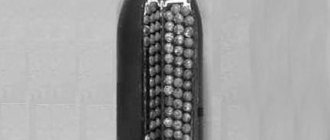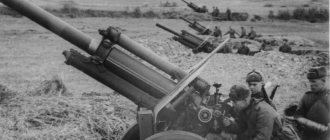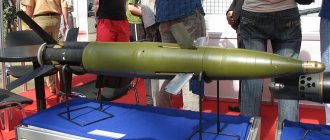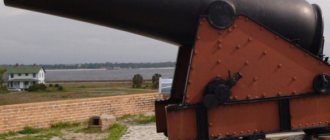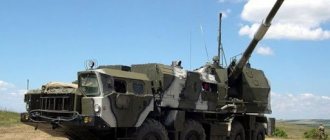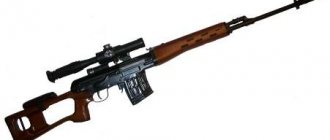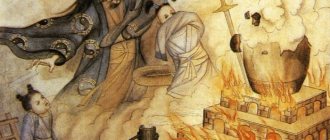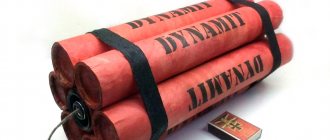A little history
Before we study shrapnel, what it is and what its role is, let's go through the pages of history. And let's talk about artillery. During the Middle Ages, when infantry on the battlefield moved in tight formation, a successful shot from a cannon could kill several people. But gradually, as small arms spread, people began to move in line. Therefore, until the end of the eighteenth century, artillery was used quite rarely against people due to its low effectiveness. The situation was slightly improved by the use of buckshot. This was the name of the metal bullets that were poured into the barrel of a gun with gunpowder. Another step forward in killing people was the use of grapeshot shells, which were cylindrical boxes stuffed with balls. Some people may have a question here. How does buckshot differ from shrapnel in practice? The fact is that using a large number of bullets at a significant distance was ineffective, since they lost their destructive power. And loading buckshot in battle is inconvenient. Although it was effective. In addition, a projectile filled with buckshot was effective at a distance that was two to three times less than that of a cannonball. Therefore, to shoot, we had to let the enemies get very close. And if a shell filled with grapeshot did not scatter the troops, destroying and putting them to flight, then the artillerymen had to engage in battle. More effective weapons were urgently needed. In 1784, Lieutenant of the Royal Artillery Henry Shrapnel proposed a device called the “shot grenade”. What was she like?
AL. Platonov, Yu.I. Sagun, P.Yu. Bilinkevich, I.V. Parfentsev
Above: grenade and shrapnel (for the soldier on the right) for a 6-inch field mortar mod. 1885, which was actively used during the Russo-Japanese War.
“Still, this Captain Shrapnel is a rare bastard. One “glass” of it can kill an entire platoon. Of course, we learned to attack under shrapnel, but it’s very dreary.” A. V. Shmalko “Phlegethon”
Illustrations from the archives of the authors and editors were used.
Henry Shrapnel.
In the literature devoted to the wars of the 19th and 20th centuries, quite often when describing the actions of artillery, one type of artillery ammunition is mentioned - shrapnel. So what kind of projectile is this and why has it received such formidable fame?
The “Russian Encyclopedic Dictionary” succinctly defines: “Shrapnel (English shrapnel), an artillery shell, the body of which was filled with spherical bullets (rods, arrows, etc.) that hit open living targets. Exploded at a given point on the trajectory; used in the 19th and early 20th centuries, replaced by fragmentation and high-explosive fragmentation shells.” This article attempts to summarize the basic data regarding the design and use of shrapnel.
In any period of development of the armed forces, the goals of increasing the efficiency of shooting were pursued; in particular, demands were placed directly on the artillery to inflict maximum damage on the enemy, which largely depends on artillery shells.
The often mentioned “Charter of military, cannon and other matters relating to military science”, published in Russia in 1621 and compiled by Onisim Mikhailov, who knew the subject well, contained 663 “decrees”, which covered in some detail the issues of the state, organization and combat use of artillery. This work contained many original thoughts. Thus, “decree 364” spoke about equipping shells with gunpowder and “faceted iron shot” - “a handful of shot per pound of gunpowder.” Apparently, we were talking about a prototype of a grapeshot grenade or shrapnel shell. However, history gave primacy in the invention of the shrapnel artillery shell to a specific person.
Henry Shrapnel was born on June 3, 1761 in Bradford-Avon, Wiltshire in southern England. Like many of his peers, Shrapnel received a military education and devoted himself to service in the British Army. He graduated from military school with the rank of lieutenant in the Royal Artillery.
During this period, artillery guns were predominantly muzzle-loading, with a smooth bore and used mainly the following ammunition: solid cast iron cannonballs; cast iron spherical powder projectiles filled with black smoky gunpowder
(in Russian artillery such ammunition weighing up to a pound, i.e. 16.38 kg, was called “grenades”, and more than a pound – “bombs”); Buckshot. Knowing perfectly well the structure and features of the action of these ammunition, in 1784 Shrapnel proposed improving grenades and bombs by placing spherical bullets mixed with a dose of gunpowder inside their bodies. It was intended to use such ammunition mainly in the battle formations of cavalry and infantry. The British military department accepted the proposed ammunition for service only in November 1803. The transition from “linear” to “perpendicular” tactics, to actions on the battlefield of deep battalion columns, made such shells very relevant.
In April 1804, the British used shrapnel shells for the first time in battles against the Dutch in Suriname (South America). The effect was noticeable. The Dutch suffered very serious losses.
Spherical shells of smoothbore artillery: a) Shrapnel; b) Boxer. A wooden washer (Spiegel) provided the direction of flight of the projectile with the tube forward.
On August 21, 1808, the Battle of Weimar (Portugal) took place, where the British used spherical shells of the Shrapnel design against the French troops, which led to significant French losses in manpower. From this moment on, spherical projectiles filled with bullets and gunpowder, with a powder tube, began to be used by the British in almost all battles of the Napoleonic Wars era. Some historians studying the defeat of Napoleon's army at the Battle of Waterlow cite the use of shrapnel shells by the British, among other factors of defeat.
By the 1830s in England, shrapnel becomes the main projectile. To ensure the remote action of such a projectile, tubes with different amounts of gunpowder were used along the trajectory, which changed the burning duration of the powder composition and determined the response time of the explosive charge of black smoky powder. The operational reliability of such tubes was extremely low: often artillerymen refused to use such ammunition in battle. But despite the fact that the shells were still far from perfect, their development and use became a real breakthrough in the development of ammunition, which allowed artillery to solve fire missions on the battlefield more effectively.
Henry Shrapnel was an inventor and worked on many artillery problems, often at his own expense. He finished his service in 1837 and retired with the rank of lieutenant general of the Royal Artillery. Henry Shrapnel died on March 13, 1842. Ten years after his death, relatives turned to the English government with a request to perpetuate the memory of Shrapnel. From that moment to the present day, projectiles filled with spherical bullets, and later with rods, prisms, etc. began to be officially called "shrapnel".
In many developed countries of the world, corresponding conclusions were made, which subsequently affected the formation of the battle order and the tactics of the warring parties. Many ammunition developers made their own modifications to the design of shrapnel and its fuses, achieving increased efficiency and an increase in the range of targets hit.
In Russia, the “system of 1838” was created and introduced in 1840 for guns. so-called grapeshot grenades and bombs, which are the same spherical projectile of the Shrapnel design.
In 1852-1855. Another English artilleryman, Boxer, developed the first extended diaphragm shrapnel, 2.6 calibers long, with a straight tube that had two parallel channels and ignited the warhead from gases. The tube allowed installation at several distances. The diaphragm provided the direction for the bullets to fly and prevented premature rupture of the charge due to heating.
In the 1860s. To equip grapeshot grenades, a column-mounted spacer tube was introduced. Such a tube had a head with four ignition channels and a body with four longitudinal channels and a firecracker. The longitudinal channels were filled with gunpowder to different lengths, which ensured burning time corresponding to distances of 500, 800, 1000 and 1200 m. The outlet holes of the longitudinal channels were covered with mastic. Before firing, the plug was removed from the ignition channel and the mastic was removed with a chisel from the outlet of the channel whose burning time corresponded to the required firing range.
Columnar spacer tube.
In the middle of the 19th century, the era of smoothbore artillery ended, as it could no longer meet the new requirements for the development of military equipment.
In Russia, during the transition from smooth-bore artillery systems to rifled ones, the first serial guns adopted by artillery order No. 128 of August 10, 1860 were 4-pound rifled guns according to the “French system” (the French adopted such guns in 1858) , charged from the muzzle. The ammunition of these guns included three types of oblong projectiles: a cast iron grenade, shrapnel and buckshot. A design feature of the projectiles, including shrapnel ones, was the use of 12 zinc protrusions (in official documents of the 1850s and 1860s they were called “wings” or “spikes”), placed in two rows on the oblong part of the projectile.
An oblong projectile with ready-made projections for muzzle-loading rifled guns.
The front six protrusions were leading, rested against the inclined combat edge and were intended to impart a rotational movement to the projectile. The rear row of protrusions served to center the projectile in the barrel. The mass of the shrapnel projectile was 6.14 kg, it contained 85 g of explosives and 62 bullets weighing 23 g and each with a diameter of 16 mm. To ensure remote action, the shrapnel projectile was equipped with a 7.5-tube. The propellant charge in the form of a 614 g sample of gunpowder provided a firing range of shrapnel bullets of about 533 m.
Rifled guns loaded from the muzzle had such a serious drawback as the breakthrough of powder gases through the gaps between the surface of the projectile and the surface of the bore. This led to a decrease in the useful work of the powder gases and to unsatisfactory combat accuracy. The reasons listed above, as well as other operational characteristics, constantly forced us to look for another solution, which led to the development and widespread adoption of breech-loaded artillery systems.
In the period from 1865 to 1877, breech-loading artillery systems - guns mod. 1867 (i.e. with a barrel bore model 1867) and guns model. 1877 All field guns mod. 1867 had a horizontal wedge breech and were intended to fire a lead-jacketed projectile. For these guns of all calibers from 2.5 to 6 inches inclusive, two types of shrapnel were used: with a central chamber and with a diaphragm. The total number of bullets placed in diaphragm shrapnel was greater than in center chamber shrapnel.
Shrapnel with a diaphragm consisted of a cast iron body, on which a lead sheath was reinforced on the outside in longitudinal and transverse grooves. Round recesses were made on the inner surface of the projectile body, intended to ensure a tighter fit of the spherical bullets to the walls. For the same purpose, longitudinal helical grooves were sometimes made on the inner surface. The chamber for the expelling charge was located in the bottom of the projectile. A diaphragm was used to separate the expelling charge from the bullets, and a central iron tube was used to transfer fire from the remote tube to the expelling charge.
Shrapnel: a) with a central chamber; b) with a bottom chamber and a diaphragm.
A yellow copper head was attached to the projectile body with screws. When loading, the bullets were poured through the head point or a special hole in the head, they were thoroughly shaken and filled with sulfur. This design of the projectile, called “the first perfect example of shrapnel,” was developed by Russian Army General V.N. Shklarevich.
Both types of shrapnel were intended to destroy infantry and cavalry. There were differences in the effect of the projectiles on the target: for open targets it was preferable to use diaphragm shrapnel, and for closed front targets it was preferable to use shrapnel with a central chamber. Thus, with diaphragm shrapnel, after the remote tube was triggered, a beam of fire was transmitted to the expelling charge, which led to the ignition of gunpowder. The pressure force of the powder gases from the expelling charge transmitted through the diaphragm caused the screw head threads to break (cut) and the bullets to be thrown forward, while the projectile body remained intact.
In shrapnel with a central chamber, a beam of fire from a remote tube ignited the gunpowder; as a result of the action of the powder gases, the shrapnel body was torn into fragments, which, together with the bullets, hit the target from above.
Russian artillerymen used such shrapnel shells during the Russian-Turkish War of 1877-1878. - mostly with guns mod. 1867. It is characteristic that in 1878 Russian factories that produced shells received an order for 791 thousand grenades, 690 thousand shrapnel, 54,150 buckshot. Ammunition for guns mod. 1877 (light and mounted, mountain, battery guns) was to include 50% shock tube grenades and 50% shrapnel and grapeshot.
The ammunition capacity of the 2.5-inch mountain gun mod. In 1885, a shrapnel shell with a steel body entered, the walls of which were much thinner than those of shrapnel with a cast iron body. Accordingly, a larger number of bullets were placed in the steel case.
In connection with the adoption of “long-range” guns mod. 1877 with steel barrels and a progressive steepness of the rifling, the angle of inclination of which gradually increased from the breech to the muzzle, Colonel Babushkin proposed an improved version of the “first sample” shrapnel. The shrapnel body was equipped with a copper driving belt located in the bottom part, and a copper centering belt pressed into a groove at the base of the ogive head. In addition, the shells became longer and more powerful.
Improved design of the “first sample” shrapnel.
However, the groove weakened the head of the projectile, especially the armor-piercing one. Later they abandoned it and switched to an annular centering thickening, which was made in one piece with the projectile body. The design of the body of an artillery shell with a copper leading belt and a centering thickening has been preserved, for the most part, to this day.
The end of the 19th and beginning of the 20th century in the development of world and domestic artillery was characterized by the development and adoption of rapid-fire guns with an “elastic carriage”. Thus, in Russia, after a long period of testing, on February 9, 1900, the “3-dm field gun mod. 1900" with piston valve. In the same year, the gun received its baptism of fire during combat operations in China. In the design solution, the 76-mm gun mod. 1900 represented a sharp qualitative leap compared to field guns mod. 1877. However, this weapon had a number of significant shortcomings that needed to be eliminated. Therefore, soon, namely on March 19, 1903, by the highest command, a new gun with a carriage with a cradle under the name “3-dm field gun mod. 1902." For the above guns, the only projectile adopted was shrapnel.
During this period, shrapnel shells were completed (finally equipped) with spacer tubes. In Russian artillery, a tube with a spacer ring was adopted in 1873. However, in the 1880s. it had to be replaced with more reliable tubes based on the Krupp model, moreover, 12-second ones - in accordance with the increase in the firing range of the 1877 systems. 76-mm shrapnel shells were initially equipped with a 22-second double-action tube, which had a remote and impact action, i.e. e. ensured that the shrapnel shell exploded in the air in front of the target and upon impact with an obstacle, respectively.
It should be noted that the impact action of the tube, in accordance with the governing documents of that time, was considered auxiliary and should have facilitated the shooting of targets (which was also facilitated by the introduction of a smoke composition into the shrapnel, which made the gap clearly visible).
Structurally, the impact mechanism was placed in the tail of the tube, and the remote one was located in its head, while they functioned independently of each other. The remote mechanism consisted of an ignition mechanism and two remote rings, of which the upper one was fixed motionless, and the lower one could rotate.
Before World War I, the scale on the outer surface of the lower spacer ring of the tube was applied by knurling in linear measures, in accordance with the divisions of the sight of 3-inch guns. Later, already during the First World War, knurling of divisions was carried out in angular measures. In addition, on the lower ring there were two marks with the inscriptions: “UD” - for installing the tube for impact action and “K” - for installation on buckshot (the industry produced tubes with factory installation on buckshot). To install a 22-s tube on any division, it was necessary to unscrew the safety cap, and then turn the lower spacer ring with a key until the required division (according to the Shooting Tables) aligns with the mark on the tube body.
General view and diagram of the device of the 76-mm Sh-354T bullet shrapnel.
As of January 1, 1904, one 3-inch gun was supposed to have 660 shrapnel. The ratio of shrapnel and high-explosive shells in Russian artillery as a whole can be judged by the fact that from 1898 to 1901, at the Ural mining plants, for example, 24,930 bombs and 336,991 shrapnel were produced on orders from the War Ministry. It is characteristic that at this time the idea of shrapnel became the basis for another type of ammunition - anti-personnel mines. An example of this is the shrapnel landmine of Staff Captain Karasev with an expelling charge and shrapnel bullets, which was used in the defense of Port Arthur.
According to the GAU of the Russian Ministry of War, the shrapnel shell was supposed to ensure the completion of all fire missions performed by field artillery. This was affected by the low effectiveness of powder grenades against earthen fortifications, which manifested itself in the Russian-Turkish War of 1877-1878, and by technological problems when introducing new high explosives into artillery, which did not allow us to evaluate the power of high-explosive grenades and bombs when equipped with new explosives. However, history quite quickly and repeatedly confirmed the harmfulness of this opinion - first during the Russo-Japanese War of 1904-1905, and then during the First World War of 1914-1918. Although Captain A. Nilus wrote back in 1892: “Shrapnel (shot grenade) can undoubtedly be recognized as the queen between shells; when acting against living targets, it is irreplaceable, but when acting against closed targets and buildings, it is weak.”
Diagram of a 22-second double-action tube.
Russian scientists thoroughly and very fruitfully studied the properties of shrapnel. Among them it is necessary to highlight V.M. Trofimov, who published the scientific work “Effect of shrapnel when firing from a 3-inch field gun” in 1903. As a result of carefully conducted experiments, Trofimov was able to determine the speed imparted to the bullets by the expelling charge, the bullet's penetration ability, the angle of expansion, the law of distribution of bullets, the number of useful hits, as well as the influence of the internal structure of shrapnel on the distribution of bullets in the cone.
During the Russo-Japanese War of 1904-1905. Russian artillerymen used shrapnel shells to inflict serious damage on the enemy in open spaces, but when manpower was hidden in trenches or simple buildings, the effect of shrapnel bullets was negligible. Due to the thin walls of the body and the weakened head part, the shrapnel did not have an impact effect, and the small powder charge provided a weak high-explosive effect. At the same time, the skillful use of shrapnel forced the Japanese command to conduct offensives at night or at dawn, and during daytime operations to intensively use self-entrenchment in order to avoid the destructive effects of Russian shrapnel. The fire of rapid-fire repeating rifles and the still relatively rare machine guns also forced the infantry to make wider use of cover and thin their ranks when attacking. The effectiveness of shrapnel was also reduced by the introduction of shields for field artillery guns and machine guns. Attempts to increase the penetrating effect of shrapnel bullets by replacing lead with steel were unsuccessful: either the mass of the bullets was insufficient, or it was necessary to reduce their number in the projectile.
The famous Soviet military historian L.G. Beskrovny, based on documents from the Russian Military Department, gives the following figures: in 1904-1905, state-owned and private military factories produced 247,000 light shrapnel (for light field guns), 317,800 light grenades and 45,590 melinite grenades for light field artillery. That is, the war caused an increase in demand specifically for grenades.
After the Russo-Japanese War, the Russian military leadership analyzed the combat use of artillery in terms of changing battle tactics, as well as the use of artillery to combat field fortifications, and made certain conclusions. As a result, in 1908, fragmentation and high-explosive grenades were included in the ammunition of field guns. However, most of it was still shrapnel. Former head of GAU E.3. Barsukov indicates the following ratios: in a combat set of guns 1/7 in melinite grenades, 6/7 in shrapnel, and in combat sets of howitzers - 2/3 in melinite grenades, 1/3 in shrapnel. In the Artillery Journal in 1906, he admitted: “It’s also very difficult to do without a grenade.” So Russian artillery in this regard did not deviate from the general framework.
Consider the effect of shrapnel on a target. In general it depends:
– on the speed of shrapnel at the moment of explosion;
– from the additional speed imparted to the bullets by the expelling charge;
– on the number of bullets and the mass of each bullet in the shrapnel, as well as the ability of bullets to maintain speed in flight;
– from the angle of expansion of bullets when bursting;
– on the law of distribution of bullets over the affected area.
Diagram of the action of a shrapnel projectile and the spread of bullets.
When shrapnel breaks, the bullets acquire additional speed (approximately 77 m/s for 76 mm domestic shrapnel). As a result of the addition of these velocities, the bullets form an expansion cone, the axis of which practically coincides with the tangent to the trajectory at the break point, and the angle 2? formed by the vertex of this cone is called the bullet expansion angle.
The affected area has the shape of an ellipse, and its size depends on the expansion angle 2? rupture interval I and incidence angle ?c. The choice of shrapnel impact angle depends on the position of the target and the conditions of the terrain at which the shooting is being conducted. For open, unprotected targets, it is advantageous to reduce the angle of incidence, while the depth of damage increases. The rupture interval and the angle of incidence are related to the height of the shrapnel rupture h by the dependence h=Itg?c.
At medium ranges and a normal burst height of 76 mm shrapnel, the depth of the affected area is 150-200 m, and the width is 20-25 m.
Hitting a target with shrapnel bullets is most likely within the so-called lethal interval, at which 50% of the bullets retain lethal energy. For domestic 76 mm shrapnel, the killing interval ranges from 320 m (at a range of 2000 m) to 280 m (at a range of 5000 m). As the burst interval increases, the number of lethal bullets decreases.
Distribution of 76 mm and 120 mm shrapnel bullets.
Depending on the range, the angle of spread of the shrapnel also changed, since it depended on the speed of the projectile and the speed of its rotation. So, when firing from a 76-mm cannon mod. 1902, for example, corner 2? at a distance of 1000 m it was 11°, at 2000 m – 13°, and at 500 m – 17.5°.
As for the design of shrapnel, the killing interval depends on the mass of the bullet. The main material used to make bullets in many countries was lead with the addition of antimony for greater hardness. In wartime, with the increase in the production of ammunition and, in particular, shrapnel, steel and cast iron were used as materials for making bullets, which reduced the mass of bullets.
The law of distribution of bullets over an area was established by firing at three shields (simultaneously with determining the angle of expansion), which were installed perpendicular to the direction of fire. After the shot, circles were drawn on the second and third shields, capturing 95% of all bullets, after which the breaking point and the angle of spread of the bullets were determined from the diameters of these circles.
The area of the circle on the third shield was divided by concentric circles into 10 rings of equal width, and for each ring the number of bullets per unit area was determined. As a result of experimental shooting, it was found that shrapnel bullets of different calibers are distributed differently.
For 76 mm shrapnel, the highest density of damage occurred in the 6th and 8th rings, while for 120 mm shrapnel - in the inner (central) rings, decreasing gradually as we approached the outer ring. This phenomenon can be explained by the different locations of bullets in shrapnel of different calibers.
Industrially developed countries (England, France, Germany, etc.) right up to the First World War considered bullet shrapnel one of the main ammunition with which artillery was able to perform all its tasks. Modern equipment and technologies were used in the manufacture of this type of ammunition.
Loading shrapnel shells in one of the UK industrial laboratories.
During the First World War, many armies, when using shrapnel, were faced with the problem of its ineffectiveness against sheltered, protected, armored and airborne targets. At the same time, there is information about successful and very effective cases of using shrapnel.
German soldiers who came under shrapnel fire from Russian 3-dm batteries nicknamed them “the scythe of death.” And there was a reason for it. For example, during the Battle of Gumbinnen-Goldan in early August 1914, the 1st Division of the 27th Artillery Brigade, supporting the infantry, concentrated the fire of all batteries on two enemy batteries in open firing positions. Within a few minutes, the German gun crews were destroyed, forcing the German infantry to retreat. Russian infantry counterattacked and captured 12 guns.
Lieutenant General Ya.M. Larionov recalled an episode of the battle of his 2nd brigade of the 26th infantry division near Drengfurt on August 26, 1914: “The German infantry launched an offensive from behind Lake Resauer... The offensive was carried out in dense combat chains, which from a distance seemed like columns. I ordered the commander of the 2nd division to open fire. The artillery of the combat sector of the 102nd Vyatka Regiment also opened fire. The German infantry turned back, carrying away the dead and wounded. Having repulsed the German infantry, the commander of the 2nd division ordered the fire to be transferred to the howitzer battery at the Drengfurt dilapidated tower. But the remote tube turned out to be short.
The division commander ordered to switch to a grenade, but even for a grenade the maximum sight was insufficient.” Here, apparently, the use of the same 22-c tubes in grenades as in shrapnel had an effect; Only since 1916 did Russian field artillery begin to receive 36-s tubes, which made it possible to increase the firing range of a grenade, while shrapnel fire was still carried out with the same 22-s tube.
On the other hand, in the journal of the meeting of the Main Directorate of the Russian Red Cross dated September 14, 1914, Fr.
On August 7, 1914, the 6th battery of the 42nd French regiment under the command of Captain Lombal opened fire with shrapnel from 75-mm cannons from a range of 5000 m at the German 21st Dragoon Regiment in a marching column, destroying the regiment with sixteen shots, putting 700 out of action Human. The famous French artilleryman General F-J. Err wrote about the battles of 1914 on the Western Front: “Our 75-mm cannon again revealed its superiority and freely developed its deadly effect on fairly close and open targets, sometimes causing a real beating of the German infantry.”
As long as shrapnel was used in the conditions and against the targets expected before the war, it gave good results. But the same Err admits that this happened before the German heavy artillery came into action, before the infantry switched to thin formations and the start of “trench” warfare. Infantry formations were thinned out, dugouts and canopies were installed in the trenches to protect against shrapnel, and batteries were more often placed in closed positions. The artillery was required to support the infantry attack, but hopes of shooting over the heads of the troops did not materialize - premature explosions turned out to be too frequent. The effect of cannon shrapnel, to a greater extent than the effect of a grenade, depended on the accuracy of the tube, and the effect of the tube itself with the powder composition was determined by atmospheric pressure, air temperature and the speed of rotation of the projectile) and on the profile of the terrain.
Unitary rounds for field guns with shrapnel shells used during the First World War.
We can cite the following data from a survey of 33,265 wounded evacuated from Moscow in September 1915: bullet wounds (with bone damage) accounted for 70%, shrapnel - 19.1%, shell fragments - 10.3%, bladed weapons - 0.6% . Those. Before the final establishment of positional forms of combat and the widespread supply of steel helmets to the army, the proportion of shrapnel wounds was still quite large.
Marshal AM Vasilevsky recalled how Russian soldiers and officers determined whether the Austrians or the Germans occupied the front in front of them: “At the beginning of each artillery firefight, we looked at the color of the explosion and, seeing the familiar pink haze that the Austrian shells produced, sighed with relief.” The pinkish color gave the burst of the Austrian shrapnel, while the shrapnel of the German field guns indicated the point of its burst with a white cloud (as did the Russian one, by the way), and the heavy howitzer - with a greenish-yellow color.
The First World War demonstrated the low effectiveness of shrapnel in hitting many targets, especially in positional warfare. In this regard, the ammunition of field batteries was changed in favor of high-explosive shells at the expense of shrapnel. Thus, in the fall of 1915, the share of high-explosive grenades in the ammunition load of Russian field artillery increased from 15 to 50%.
Russian artilleryman E.K. Smyslovsky cited the following average theoretical percentage of hitting targets when firing 3-inch shrapnel, subject to the most favorable average interval and burst height:
It is not surprising that the use of shelters by the infantry caused a sharp increase in the cost of shrapnel to kill one soldier.
Almost starting from the first months of the First World War, during the transition to well-developed positional defense in engineering terms, the artillery of all the warring countries faced the problem of how to ensure the effective defeat of the enemy located in field fortifications. In this regard, there was an urgent need to solve two main problems: to increase the angle of incidence of the projectile and the power of the projectile. To solve the above problems, artillery guns such as howitzers were most suitable, since light rapid-fire guns turned out to be ineffective against targets hidden in field structures (even light ones) due to the flatness of their trajectory and - what is more significant - due to the low power of the projectile.
Thus, all the warring states had to begin supplying their artillery with howitzers quite intensively, and by the end of the war of 1914-1918. the percentage of howitzer artillery rose to 40 or more. As for the composition of the howitzers' ammunition, shrapnel was also present there (it was believed that howitzer shrapnel retained its role because it could “look” into the trench). In addition, howitzer shrapnel accommodated more bullets of greater weight, “placed” them thicker and more evenly (closer to the normal distribution law), and when firing at artillery positions it was less intercepted by gun shields.
Shrapnel shells explode over positions. World War I.
The famous German artilleryman G. Bruchmüller, describing the actions of German divisional and corps artillery in 1916 on the Russian Front, mentions the use of 10-cm and 12-cm shrapnel by heavy howitzers of anti-battery warfare groups. But already in 1917, for the Russian and Western fronts, he paid almost no attention to shrapnel, speaking of “fragmentation shots.” Here, however, the fact that the pre-war reserves of shrapnel had run out also played a role.
It is also necessary to note the fact that shrapnel and a remote tube were more expensive to produce than a high-explosive fragmentation grenade and a contact fuse, and this, in conditions of mass production, especially during the war, led to additional government costs when placing orders at private enterprises and abroad . Head of the GAU during the First World War A.A. Manikovsky noted in his work “Combat Supply of the Russian Army in the War of 1914-1918”: “If at a state-owned factory 122-mm howitzer shrapnel cost 15 rubles. per shell, the private plant received 35 rubles. 76 mm, respectively, 10 and 15 rubles.” The cost of a 76-mm, 122-mm and 152-mm high-explosive grenade was 9, 30 and 48 rubles at state-owned enterprises, and 12.3, 45.58, and 70 rubles at private factories. respectively. Taking into account the enormous consumption of shells during the First World War, this was another important argument in favor of the grenade, in addition to its more effective action against sheltered enemy infantry and artillery.
The low combat effectiveness of shrapnel shells in trench warfare, as well as the emergence of new targets - armored cars, airplanes, tanks - contributed to the development of new types of ammunition.
The ending follows
Table of contents
Henry Shrapnel's Buckshot Grenade
It was a solid, hollow sphere. In addition to the traditional gunpowder and bullets, it had a hole in the body for the ignition tube (see photo above). The material used was usually wood. The tube was used both as an igniter and a moderator. Knowing its length, it was possible to calculate the time before the shot and achieve accuracy in hitting the desired object at the entire firing distance. There was another important difference. When a shrapnel grenade, named after its inventor, exploded, not only the bullets, but also its fragments scattered. At the same time, all living things received significant damage. It was adopted into service in 1803 by the British War Ministry. And its inventor received the rank of major. The shrapnel grenade was first tested in 1804. It was then in the spring that the British squadron, commanded by Captain Hood, first used this weapon on the battlefield.
Links
- xlt.narod.ru/Text_artillery/ch5.html
- www.battlefield.ru/content/view/141/71/lang,ru/
- otvaga2004.narod.ru/publ_w4/008_shrapnel.htm
When writing this article, material was used from the Encyclopedic Dictionary of Brockhaus and Efron (1890-1907).
| Special purpose: | Propaganda | Smoke | Lighting | Sighting and target designation | Non-lethal |
| Auxiliary purposes | Carriage proof | Slab testing | Practical | Educational | Singles |
| BPs are also classified into sub-caliber/caliber/over-caliber, active/active-reactive/reactive | |
Napoleon's defeats
This French emperor-general was able to bring more than one army to its knees. By profession he was an artilleryman. One of the secrets of his success was his development of this particular type of troops, with which Napoleon did not part. An example is the crossing of the Alps, when it suddenly fell on the Austrians and defeated them during the Battle of Marengo, which took place in 1800. Smoothbore guns of that era could fire grapeshot at a distance of up to 500 meters, while cannonballs flew at 1200. But this was not enough to fire at the entire battlefield from one position. In addition, artillerymen often had to engage in hand-to-hand combat with enemy cavalry and infantry. To correct this, Napoleon used the tactic of creating special artillery reserves that could be quickly transferred between different sectors of the battle. Who knows, if he had shrapnel, perhaps history would have developed differently. The French first encountered this development of the British in 1808, when in July Arthur Wellesley defeated the troops of General Junot. After this, Napoleon issued an order to collect the shells that did not explode, study them and create their own production. But the French never managed to figure out what their secret was. This, by the way, had significant consequences and played a role in the final defeat of Napoleon. Initially, he lost in battles with the army of the Russian Empire. But during Napoleon’s last battle at Waterloo, when he met with the already mentioned Arthur Wellesley, it was shrapnel that allowed the latter to hold out until the approach of Field Marshal Blucher and the Prussians led by him. This is the significance of this artillery shell for world history.
Content
- 1 Development
- 2 British adoption of artillery
- 3 World War I era 3.1 Technical considerations
- 3.2 Tactical use
- 3.3 Benefits
- 3.4 Disadvantages
- 3.5 Replacement with high-explosive fragmentation projectile
- 3.6 Options
Improvement
Soon rifled guns began to appear. And the Russian officer Vladimir Shklarevich developed a new type of weapon - an artillery shell. What was its peculiarity? The design provided that the fire from the primer to the explosive charge had to travel through three sections. One of them was a central tube. The other two sections were channels containing pyrotechnic material similar to the composition of the rotary rings. Thanks to them, it was possible to measure how much charge would burn during the flight. In addition, the projectile was additionally detonated at a specific distance. This was an extremely convenient innovation, which was received with great enthusiasm by the artillerymen. Russian specialists also developed a detonation mechanism called “blow”. In this case, it was envisaged that the main charge would explode at the moment the projectile hits the target. The artillerymen generously treated the troops of the Ottoman Empire during the war of 1877-1878 and the Japanese in 1904-1905 with similar gifts.
Death in the open air
At the beginning of August 1914, the batteries of the first division of the 27th artillery brigade opened fire on open German artillery positions. Then, in a few minutes, the gun crews were destroyed, which forced the infantry of the German army to retreat. The soldiers of the Russian Empire then went on the attack and were able to capture twelve guns. One more example. In the same year, on August 7, the sixth battery of the forty-second French regiment opened fire with shrapnel shells from its cannons at the dragoon formation of the German army. Then it took only 16 shots to kill and wound approximately 700 people.
Current situation
Shrapnel is not widely used today. It was replaced by a fragmentation shell. But steel balls have not lost their relevance as destructive elements. They were modified, modernized and survived to this day. So, the S-75 anti-aircraft missile has the same steel balls (or pyramids) and a similar operating principle. Shrapnel weapons are also in service with the countries of the so-called West. True, modern requirements in the form of hitting specific targets rather than area targets limit the possibilities of using such weapons. So we basically looked at shrapnel, what it is, where it was used, what the history of its use is, and so on. Let's also pay attention to the details in order to better understand the topic of the article.
World War I: the decline of shrapnel
Before the outbreak of the First World War, shrapnel was in service with all European armies. Moreover, for medium caliber mountain and field artillery this type of ammunition was predominant. Shrapnel shells were very effective in the first stage of the campaign, when combat operations were of a maneuverable nature, but after the start of trench warfare their significant shortcomings became apparent. These include the following:
the relatively small mass of the bottom charge determined the low lethal effect of spherical shrapnel bullets; one could easily hide from damaging elements in trenches, communication passages and, even more so, in caponiers or dugouts; shooting with shrapnel required artillerymen (especially officers) to have a high level of training and decent practice, which the reservists who went to the front en masse could not have; shrapnel shells had a complex design and, accordingly, were expensive. Given the gigantic amount of ammunition that the front regularly required, this deficiency meant a lot.
Therefore, already in the middle of the war, shrapnel shells began to be massively replaced by instant high-explosive fragmentation shells. They did not have the above-described disadvantages, in addition, they had a strong psychological impact on enemy soldiers.
Shrapnel bullets caused horrific injuries
A little more about buckshot
The general principle of its operation was described earlier. Some may find the method of using buckshot rather inconvenient. And this is true, because the bullets were not simply poured into the barrel, but for convenience they were folded into a small box, which broke at the moment of the shot. Due to this, bullets flew out of the gun in a wide sheaf. By the way, buckshot has also survived to this day. True, they use it either in small-caliber guns for defense, or in pump-action shotguns. Henry Shrapnel made a small improvement in terms of structural strength and decided to put some gunpowder in the box itself. Therefore, it flew to the enemy soldiers and only then exploded. Thanks to this effectiveness in terms of destruction, shrapnel became widespread. What was it like in comparison with buckshot? Heaven and earth! Shrapnel could be fired over a considerable distance without losing its effectiveness. Whereas buckshot had a maximum range of up to 500 meters. But in practice, the enemy was allowed much closer for maximum effectiveness.
Types of shrapnel projectiles
The original design was not bad. But since then it has changed significantly. There are various options for creating shrapnel. Let's look at what is offered to artillerymen:
- Shrapnel grenade. It has a head that separates together with the tail bushing, where the transfer charge is placed, which is often used as compressed TNT.
- High explosive shrapnel. Does not have a separate head. Bullets are ejected in the usual manner. A significant disadvantage is the relatively weak explosion. But alas, full detonation does not always occur.
- Rod shrapnel. Instead of balls, steel hollow tubes filled with lead are used.
- Stick shrapnel. This is an attempt to improve clause 3.
- Shrapnel with explosive elements. Created for larger-scale damage.
- Shrapnel with a tracer device. Used to highlight the sky and more accurately adjust the fire.
Impact on development
Shrapnel greatly influenced the future of artillery. Thus, the principle of its action was used to create incendiary and chemical projectiles. Only, not steel balls, but a certain substance were placed in the shell. And upon impact, the shell exploded, igniting everything around, or emitting toxic gases. We should also not forget about fragmentation shells, which use a similar principle of destroying people. But they are now considered one of the most effective in the fight against enemy infantry.
Sources [edit]
- Bethel, Georgia. 1911. Modern Field Artillery—A Description of Field Army Artillery, Principles and Methods of Its Use
. London: Macmillan and Co Limited - Hogg, OFG. 1970. Artillery: Its Birth, Rise and Decline
. London: K. Hirst and Company. - Keegan, John. The face of battle
. London: Jonathan Cape, 1976. ISBN 0-670-30432-8 - A. MARSHALL, FIC (Chemical Inspector, Indian Ordnance Department), "Invention and Development of the Shrapnel Projectile" from the Royal Artillery Magazine, January 1920.
- Sheldon, Jack (2007). The German Army on the Somme 1914–1916. Barnsley, South Yorks, UK: Pen & Sword Military. ISBN 978-1-84415-513-2. OCLC 72868781.
